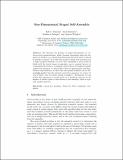| dc.contributor.author | Demaine, Erik D. | |
| dc.contributor.author | Eisenstat, Sarah Charmian | |
| dc.contributor.author | Ishaque, Mashhood | |
| dc.contributor.author | Winslow, Andrew | |
| dc.date.accessioned | 2012-10-10T15:54:04Z | |
| dc.date.available | 2012-10-10T15:54:04Z | |
| dc.date.issued | 2011-09 | |
| dc.date.submitted | 2011-09 | |
| dc.identifier.isbn | 978-3-642-23637-2 | |
| dc.identifier.issn | 0302-9743 | |
| dc.identifier.issn | 1611-3349 | |
| dc.identifier.uri | http://hdl.handle.net/1721.1/73835 | |
| dc.description | 17th International Conference, DNA 17, Pasadena, CA, USA, September 19-23, 2011. Proceedings | en_US |
| dc.description.abstract | We introduce the problem of staged self-assembly of one-dimensional nanostructures, which becomes interesting when the elements are labeled (e.g., representing functional units that must be placed at specific locations). In a restricted model in which each operation has a single terminal assembly, we prove that assembling a given string of labels with the fewest stages is equivalent, up to constant factors, to compressing the string to be uniquely derived from the smallest possible context-free grammar (a well-studied O(logn)-approximable problem). Without this restriction, we show that the optimal assembly can be substantially smaller than the optimal context-free grammar, by a factor of Ω √n/log n even for binary strings of length n. Fortunately, we can bound this separation in model power by a quadratic function in the number of distinct glues or tiles allowed in the assembly, which is typically small in practice. | en_US |
| dc.language.iso | en_US | |
| dc.publisher | Springer Berlin / Heidelberg | en_US |
| dc.relation.isversionof | http://dx.doi.org/10.1007/978-3-642-23638-9_10 | en_US |
| dc.rights | Creative Commons Attribution-Noncommercial-Share Alike 3.0 | en_US |
| dc.rights.uri | http://creativecommons.org/licenses/by-nc-sa/3.0/ | en_US |
| dc.source | MIT web domain | en_US |
| dc.title | One-dimensional staged self-assembly | en_US |
| dc.type | Article | en_US |
| dc.identifier.citation | Demaine, Erik D. et al. “One-Dimensional Staged Self-assembly.” DNA Computing and Molecular Programming. Ed. Luca Cardelli & William Shih. LNCS Vol. 6937. Berlin, Heidelberg: Springer Berlin Heidelberg, 2011. 100–114. | en_US |
| dc.contributor.department | Massachusetts Institute of Technology. Computer Science and Artificial Intelligence Laboratory | en_US |
| dc.contributor.department | Massachusetts Institute of Technology. Department of Electrical Engineering and Computer Science | en_US |
| dc.contributor.mitauthor | Demaine, Erik D. | |
| dc.contributor.mitauthor | Eisenstat, Sarah Charmian | |
| dc.relation.journal | DNA Computing and Molecular Programming | en_US |
| dc.eprint.version | Author's final manuscript | en_US |
| dc.type.uri | http://purl.org/eprint/type/ConferencePaper | en_US |
| dspace.orderedauthors | Demaine, Erik D.; Eisenstat, Sarah; Ishaque, Mashhood; Winslow, Andrew | en |
| dc.identifier.orcid | https://orcid.org/0000-0003-3803-5703 | |
| dc.identifier.orcid | https://orcid.org/0000-0002-3182-1675 | |
| mit.license | OPEN_ACCESS_POLICY | en_US |
| mit.metadata.status | Complete | |
